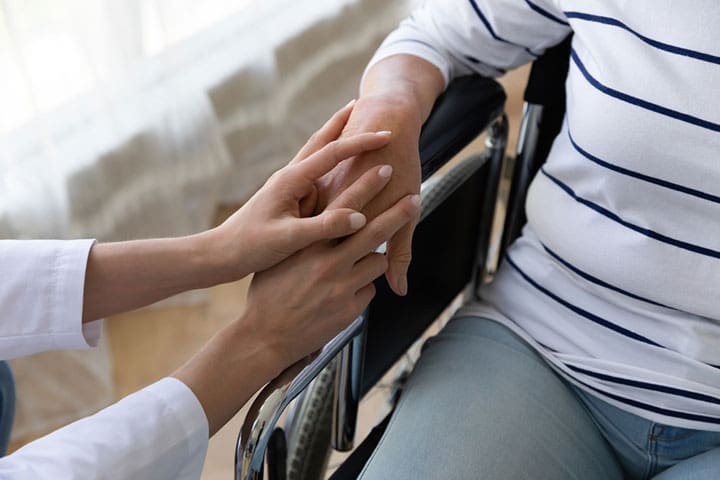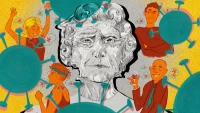Your quick action ensures a good outcome.
Takeaways:
- Autonomic dysreflexia results from a noxious stimulus, such as a distended bladder or bowel.
- Signs and symptoms include sweating, hypertension, headache, nausea, nasal congestion, and blurred vision.
- Promptly removing the noxious stimulus can help reverse the condition.
June Coleman*, a 28-year-old woman, is flushed and diaphoretic when her friend wheels her into the emergency department. Ms. Coleman, who suffered a spinal cord injury at T5 a year ago and is paraplegic, complains of a throbbing headache, nausea, and spasms in her inner thighs. Your assessment reveals that her HR is 64 beats per minute (described by Ms. Coleman as bounding) and her BP is 206/114 mmHg.
Ms. Coleman tells you that 2 days ago she noticed increasing difficulty with self-catherization and draining her bladder. This morning, she again couldn’t self-catheterize. Shortly after, she began profusely sweating and developed a severe headache.
The patient’s history, signs, and symptoms lead you to suspect autonomic dysreflexia, a potentially life-threatening condition common in patients with a spinal cord injury at or above T6. The condition results from a noxious stimulus below the level of the injury, which triggers a sensory message to the brain. The injury prevents the message from reaching the brain, so the sympathetic nervous system’s response goes unopposed. Vasoconstriction below the level of the spinal cord injury may result in pale, cool, and clammy legs with piloerection. It also triggers a dramatic increase in BP, which can produce a throbbing headache. Carotid and aortic baroreceptors respond to hypertension by triggering vasodilation, resulting in diaphoresis and flushing above the level of injury.
Taking action
Severe hypertension can cause a stroke, so you know that your first priority is identifying and removing the noxious stimulus. A rapid assessment reveals a distended bladder. Quickly relieving the distention may resolve the dysreflexia.
To reduce the risk of exacerbating the patient’s condition, you apply 2% lidocaine jelly to the urethra 3 to 5 minutes before you begin catheterization. After catheterization, you check Ms. Coleman’s BP and HR every 2 to 5 minutes. Ten minutes after her bladder is drained, Ms. Coleman’s BP begins to fall and she seems less anxious.
Education and follow-up
A distended bladder or bowel are common causes of autonomic dysreflexia. Other triggers include cutaneous pressure, lack of mobility, pressure injuries, and bowel or bladder stimulation used in patients with paraplegia.
Autonomic dysreflexia usually comes on suddenly. Other signs and symptoms include nasal congestion, blurred vision, chills without fever, bradycardia, nausea, and unusually frequent spasms of the abdomen or lower extremities.
If you can’t quickly identify the noxious stimulus, consult the emergency physician or patient’s provider to discuss the best regimen for decreasing the blood pressure.
Outcome
You monitor Ms. Coleman’s BP for 2 hours after her symptoms resolve. They don’t recur, so she’s discharged home.
Before discharge, you teach Ms. Coleman and her caregivers how to recognize dysreflexia triggers and its signs and symptoms, and you provide written materials that explain how to identify and remove noxious stimuli. You also review catheter insertion with Ms. Coleman and ask if she has a relative or friend who can help. You emphasize the importance of calling for help as soon as she has trouble with self-catheterization or if she experiences symptoms of dysreflexia and can’t identify and remove the stimulus quickly.
Your quick action prevented life-threating complications. In addition, your patient education helped to ensure Ms. Coleman will know what to do if she experiences autonomic dysreflexia in the future.
*Name is fictitious.
Kevin D. Tipton is associate professor of nursing at Southern Utah University in Cedar City.
References:
Duvall J, Mathew PG, Robertson CE. Headache attributed to autonomic dysreflexia: Clinical presentation, pathophysiology, and treatment. Curr Pain Headache Rep. 2019;23(11):80. doi:10.1007/s11916-019-0818-5
Eldahan KC, Rabchevsky AG. Autonomic dysreflexia after spinal cord injury: Systemic pathophysiology and methods of management. Auton Neurosci. 2018;209:59-70. doi:10.1016/j.autneu.2017.05.002
Koyuncu E, Ersoz M. Monitoring development of autonomic dysreflexia during urodynamic investigation in patients with spinal cord injury. J Spinal Cord Med. 2017;40(2):170-4. doi:10.1179/2045772315Y.0000000049
Lakra C, Swayne O, Christofi G, Desai M. Autonomic dysreflexia in spinal cord injury. Pract Neurol. 2021;21(6):532-8. doi: 10.1136/practneurol-2021-002956
Milligan J, Lee J, McMillin C, Klassen H. Autonomic dysreflexia: Recognizing a common serious condition in patients with spinal cord injury. Can Fam Physician. 2012;58(8):831-5.
Key words: Autonomic dysreflexia, self-catheterization, noxious stimulus



















1 Comment. Leave new
Excellent